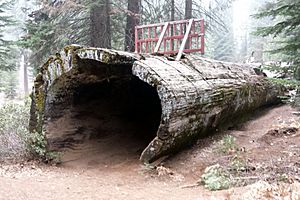Hollow Log (Balch Park) facts for kids
The Hollow Log is a famous part of Balch Park in Tulare County, California. It's actually a huge, hollowed-out log from a fallen Giant Sequoia tree. This amazing log is one of the most popular sights in the Mountain Home Grove, which is a forest full of Giant Sequoia trees around Balch Park.
Contents
History of the Hollow Log
Early Discoveries and Uses
Long ago, Native Americans who lived near the Tule River knew about the Hollow Log. The first time it was written about was in 1856. At that time, soldiers used the log as a base. They were patrolling the area during a conflict known as the Tule River Indian War.
For many years, people called it the "Soldiers Log." It became a popular spot for settlers visiting the Giant Sequoia trees nearby. One early visitor was a sheep farmer named Clinton T. Brown. He carved his initials and the year 1870 into the log.
The Summer Home Resort
In 1885, a man named John J. Doyle bought the land where the log was. He planned to build a vacation spot called "Summer Home." First, he used the log as a place to live. Later, he used it as a cool storage room for apples from his orchard.
In 1888, Doyle tried to move the log. He had one end sawed off. He wanted to put the log on wheels and use it as a dining car for a train trip across the eastern United States. But the log was too big! It wouldn't fit through the train tunnels.
So, the Hollow Log stayed put. It became the main attraction at Doyle's Summer Home resort. For a few years, many tourists visited this popular place. Later, Doyle sold his property in 1906. The log and the surrounding trees were bought by the Mt. Whitney Power Company.
Preserving the Log for the Future
The land eventually went to Allan and Janet Balch. In 1930, they gave the property to Tulare County. They wanted to make sure the Hollow Log and the Giant Sequoia trees would be saved. Thanks to them, these natural wonders are preserved for everyone to enjoy for many years to come.
Dimensions of the Hollow Log
The Hollow Log is about 75 feet (23 meters) long. It has a diameter of about 15 feet (4.6 meters). It used to be longer, but part of it was sawed off in 1888.
Today, strong steel cables are wrapped around the log. These cables help keep it from falling apart. Even with the cables, you can still walk and crawl all the way through the log from one end to the other. It's a really cool experience!



